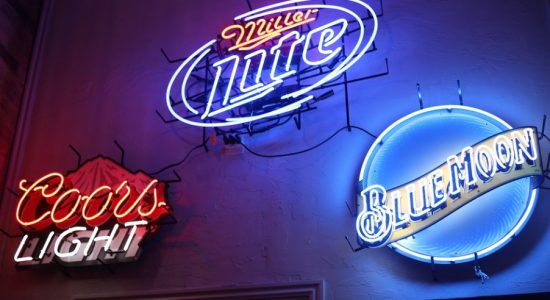What is Ice Beer? And How is Ice Beer Made?
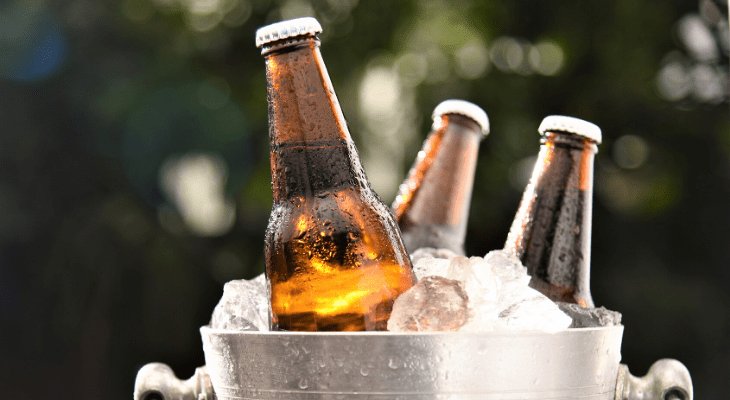
The first insertion of this term is some kind of slush ice beer, right? But don’t worry, that’s not what ice beer means. Ice beer is simply another way of thinking while talking about brewing. The process used under ice beer brewing is called fractional freezing or freeze distillation.
What is ice beer? Ice beer is roughly a Canadian term for pale lager which has been through fractional freezing during production. The alcohol (ethanol) has a much lower freezing point than water, so when the ice is removed from the beer, the alcohol is said to increase.
But, there is much more to know about ice beer, so keep reading for more knowledge about this beer type.
Read Also: Best Beer Recipe Kits
What Exactly Is an Ice Beer?
Ice beer is actually just a beer that has been chilled until ice crystals are being formed. This became popular in the 1990s in the United States, Canada, the UK, and Japan. In Canada, the ice beer is also a term for a pale lager.
It is said that the cold temperature makes a chill haze and precipitation, among others, which are filtered out. The outcome should supposedly be a clear and clean tasting beer, a little stronger than if it was brewed regularly instead.
This method is known as freeze distillation.
The water freeze at a higher temperature than the ethanol. This means, that the ice in the beer will contain water but not alcohol. When the ice is removed, there will be a more concentrated beer left.
This method can be used to make stronger beers. Some of these beers are the German Eisbock.
German Eisbock
The German Eisbock has a pretty funny story. This type of beer should supposedly have been invented by a coincidence.
It all started in the local German Reichelbräu brewery (which is now part of Kulmbacher AG) when an apprentice was told to move a barrel off beer from the cold outside, into warmer parts.
This was a cold winter evening in 1890. The apprentice forgot all about the barrel, and the barrel was left outside in the cold.
The next morning much of the beer was frozen, and the ice inside the barrel had extended to a degree where the wooden staves eventually broke. The next day the barrel was found by the head brewer.
He found the barrel busted and a block of ice encapsulating a small amount of dark liquid. This liquid proved to be far tastier than expected. And this is how the Eisbock was invented, or at least it’s how the story is told in Kulmbach.
This story, however, is not to be found in any German brewing books of the time.
The Eisbock was put on the market and is still one of the commercially available beers of the style. But, whether this great story is true or not, we don’t know for sure.
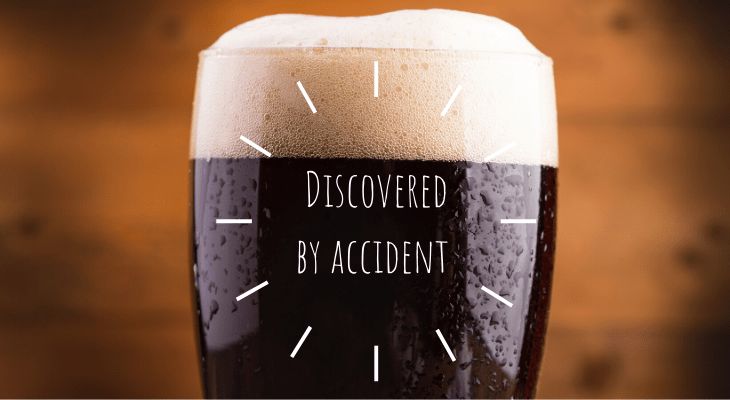
The History About Ice Beer
As mentioned above, the ice beer was invented by brewing a strong and dark lager where the beer was frozen down to then be able to remove some of the ice to obtain a more concentrated beer.
This concentrates the aroma and the taste, and it also raises the alcohol content in the finished product. This can produce beer with an alcohol strength of up to 12 to 15 percent. In Northern America, water was added to lower the alcohol level.
Ice beer became current in Canada in 1989 by the microbrewery Niagara Falls Brewing Company. The brewers started the freezing method on strong, dark lagers. Here they maintained to increase the alcohol strength to around 8% ABV.
But, the large Canadian brewer, Molson, claimed to have made the first ice beer in Northern America with the introduction of Canadian Ice in April 1993.
Labatt, Molson’s competitor, claimed to have patented the ice beer process earlier. So, when Labatt introduced an ice beer in August 1993 it started the so-called ‘’Ice Beer Wars’’.
Is Ice Beer Good?
Most ice beers are good beers, and some are unfairly bad. Personally, I think that most ice beers are fine. Try not to buy them too cheaply, you may regret that. That said, it is possible to find some relatively cheap ice beers that are actually fine.
In the following, I will give you my review on a couple of ice beers and one Eisbock.
The Kulmbacher Eisbock
This beer has a rich amber color and beautiful clarity. As beautiful as the color is, as surprised you’re getting while taking the first sip. Also, you’ll find big raisin and plum aromas tucked within the prominent alcohol scent.
This beer is very drinkable because of the healthy dose of roasted, caramelized malted barley upfront, balanced shortly thereafter by a peppery hop character typical of the style.
The taste is finished with a sweetness of brown sugar. This beer has 9.2% AVB.
Busch Ice Beer
Busch Ice has a sweet and smooth finish. It also has a higher alcohol content than an average beer.
Busch is brewed with a mix of American-grown and imported hops and a combination of malt and corn to provide a pleasant balanced flavor and has 5.9% ABV.
Busch ice is a smooth-tasting ice beer that gives you a sharp taste and a cold sense which can be enjoyed at any occasion.
Molson Ice Beer
Molson Ice is produced by Molson-Coors Canada Inc. This is the Canadian division of the world’s fifth-largest brewing company, the Molson Coors Brewing Company.
Molson Ice is an award-winning brew, slowly fermented with Molson’s prize lager yeast and is then ice-filtered just before being bottled.
Molson Ice has a clear, golden amber appearance with nice foam and lacing. Its aromas are of sweet malt, and a hint of corn and hops. The taste is light on the carbonation, refreshing with a slightly dry, hoppy finish, and a sweet closure. This ice beer has 5.6% ABV.
These three beers are all, as you probably know, ice beers (one Eisbock). And all three beers are good and concentrated with ABV from 5.6% to 9.2%, which is typical for an ice beer.
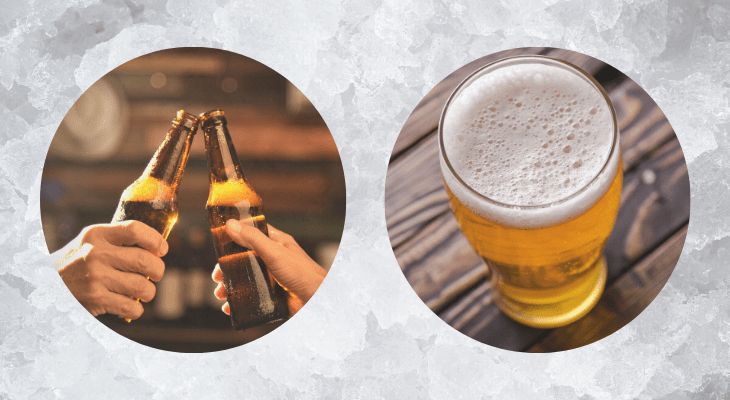
How Is Ice Beer Made?
There are different ways to make an ice beer, and you can make ice beer out of any beer type. But, one thing is that you can make ice beer out of any beer type, another thing is that you shouldn’t do it out of any beer type.
Some beer types are better for this purpose than others. For example, a Helles beer. If you want a Hells beer with a higher ABV and concentrated flavors, just increase the poundage of grain in the recipe and choose more intense character, grains, and hops.
The best beer styles for an ice beer is the one who already lives at the upper limits of flavors and ABV.
Before you start, you have to consider a recipe. This following recipe will take statement in a Baltic porter. And again, this is not an unwritten recipe, this is just an example of how you could do it. Let’s begin, shall we?
Ice Beer Recipe
- For this recipe, you’ll need around 15 pounds of base grains and around half a pound of each three crystal and chocolate malts.
To concentrate the flavors leave the base malt alone. However, keep an eye on the crystal and chocolate malts. The higher up the Lovibond scale you go, the more you’ll consider decreasing the amount you’re using or pivoting to a less-assertive substitute.
Lovibond is also known as degrees Lovibond or abbreviated as L. It is a scale for measuring color. To determine color the sample is placed in a tintometer.
The tintometer contains several numbered discs of tinted glass. The Lovibond color is the value assigned to the disc whose color matches most closely to the sample. But, it also comes in electronic test pens.
- Try, as far as possible, to reach for more than 65L. When +65L. is reached you should either eliminate the malt or replace it with something milder.
- It’s fine to leave the hops alone, but you should reduce your IBU load by more than your anticipated concentration percentage. A linear reduction may lead to a high impression of bitternessTo avoid this, try to take your anticipated concentration and apply a 1.25 multiplier to it, and reduce your calculated IBUs by the same amount.
Remember to always use a clean yeast for your ice beer.
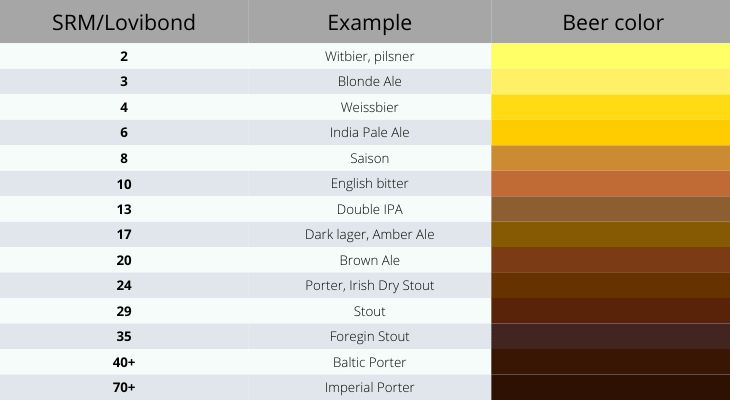
Are you a home brewer, or simply just would like to be one? you should definitely read this post: Best Beer Recipe Kits
Ice Beer Process
- If possible, try to make an attenuation-heavy beer.
- At the mash process, try to go down to a temperature of 148°F (64°C), on the hot side.
- On the cold side, manage your fermentation aggressively. To get a clean start you should oxygenate well, and then start cool for the first 72 hours. Afterward, ramp up the temperature to encourage a full attenuation.
- The purpose of this process is to minimize all the off-flavors, depending on the style, of course.
- After fermentation, the beer should taste a little bit thin and a little sweet.
And now the freezing process can begin!
There are mainly two ways to do this; a fast way, and a slower way. This process takes a starting point in slow method, to make a more accurate concentration. However, in both processes, generate your ice and rack out from underneath it before packaging.
- This slower process will take around 8-10 hours at 22°F (-5°C).
- And now bottle conditioning. This is still possible with ice beers, and even without adding more yeast. This might take a while, but yeast is hardy. That said, force-carbonation is also a possibility.
When your ice beer is young, you might be able to taste some sharp flavors. These flavors are good candidates for extended lagering. Try to let the lager age for eight weeks before evaluating.
Also, consider to cellaring a sample of bottles for half a year, or even a whole year.
Take a look at this post: What Are The Best Home Brewing Kits For Beginners?
What’s the Difference Between Ice Beer and Regular Beer?
That’s a great question. I mean, if you don’t know the difference, why drink ice beer rather than regular beer, right? To know the difference you have come to the right place.
Regular beers, as we know them, contain alcohol which is produced naturally during fermentation by yeast. But, yeast can only produce alcohol up to 8-15% depending on the strain of yeast.
The ice beer has a higher alcohol content than regular beer. So, how is this achieved? By a so-called freeze distillation process which is a type of fractional crystallization.
You just start with a beer which is a mixture of alcohol and water with some sugars and other carbohydrates. So basically you can do this with any beer. However, that does not mean you should do it with any beer kind.
You allow the beer to freeze partially. the alcohol in the beer will not freeze at these temperatures. When it has been allowed to freeze into ‘’beer-slush’’ you remove the ice crystals which have formed and discard them.
Then, you let the resulting beer solution melt, and then freeze it again, so you can remove even more ice crystals. You’ll go through this process several times.
By this process, the water will be removed, in the form of ice, and the alcohol stays behind and gets concentrated in the remaining liquid. So the alcohol concentration is being increased, simply by removing water.
The sugars or flavor compounds that may or may not be present are also being concentrated in this process. Sweetness and hop flavors, and or any off-flavors that might be present are increased as well.
It is a must to start the freezing distillation off with a good, clean beer. Otherwise, the result will be bad.
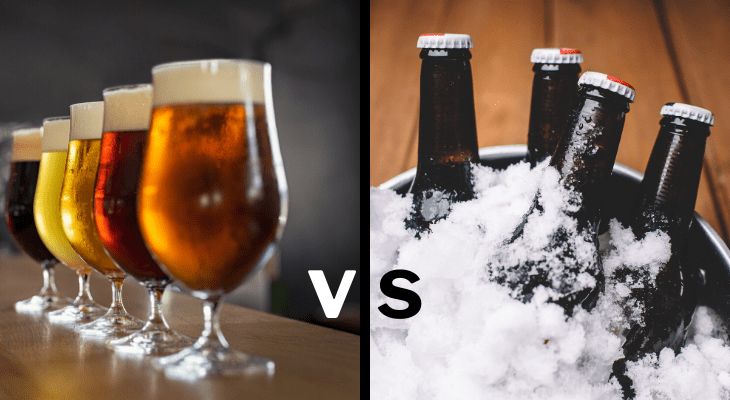
What Does Ice Beer Taste Like?
There is a lot of different ice beer variants, but one thing they all have in common is the more concentrated taste and higher alcohol content than most other beers. That said, the alcohol content is not that higher than in a regular beer.
Ice beer is only slightly higher in alcohol than an average American lager counterpart. Most ice beers are anywhere from 5.0% to 6.5% ABV compared to the average American lager that has around 4.5% to 5.0% ABV. And that’s just an example of the American lager.
The average microbrews have 5.0% to 7.0% ABV in a typical Pale Ale, India Pale Ale or Lager.
Anyhow, let’s get back to the taste of an ice beer. Almost all ice beers have a low-to-moderate body with a hint of residual sweetness. Perhaps it’s because the beer is a bit more concentrated.
The hop and malt flavor is very clean with no fruitiness or other off-flavors, around the same as in every American macro lager.
To many people, ice beer is not that big of a deal. It’s a cheap beer with a slightly higher ABV than other average beers. So, when choosing your next ice beer, try not to buy them too cheap.
While talking about ice beer there is a huge difference between Eisbocks and American Ice beers. As mentioned above regular ice beers are all about the increased alcohol content, and brewers of these beers care little about changing the flavor.
Eisbocks, on the other hand, is all about the flavors, and the alcohol is just an extra. Eisbocks is the big brother to the German Doppelbock. With its flavor, body, and alcohol, these beers are way different from the American Ice Beer, and it should be respected.
The Eisbock beers can range from 9% to 14% ABV and are almost black in color. The flavor and hop bitterness are mostly cast aside with a big alcohol presence. This can go from sweet to spicy, and from fruity to sometimes fusel.
The Eisbock has gone through almost the same process as an ice beer but lower temperatures are needed due to the higher alcohol strength that this beer begins with.
Also read: What Every Home Brewer Needs
What Is Natural Ice Beer?
A Natural Ice Beer is an ice beer brewed by Anheuser-Busch. And this ice beer is kind of funny. As I mentioned above, most American Ice Beers are kind of lack to many people, because of the taste and the cheap prices.
This Natural Ice Beer is one of them. It’s that kind of beer without any characteristics, it’s just a beer with a slightly higher alcohol content than other average beers and almost a boring taste, I would say. So, just a beer, nothing more.
However, some actually think this is one of the best American Ice Beers you can get.
So, If you thought this was some kind of a beer type, I will have to disappoint you. It’s simply just an American Ice Beer. But, even though I’m not quite a fan of this beer, I still made a short review.
Appearance: Something ice beers do is that they appear very clear and beautiful. The Natural Ice Beer pours a golden yellow color that is very clear.
At first, I was pretty impressed by the head of the beer. It seemed thick and pure white, but within a couple of seconds, it all disappeared into nothing.
Aroma: This beer does not give you much of an aroma. Though, it is possible to smell a bit grain, corn, and a hint of alcohol.
Mouthfeel: It’s pretty watery and slightly bubbly. The carbonation is pretty messy, and the beer has almost no body.
Taste: The taste is not much either. You get a bit of sweetness, corn, and a hint of breadiness/yeastiness. No real off-putting tastes so to speak.
So yeah, this beer is not awful, but it’s not something I wouldn’t buy again if I had other options.
For more knowledge about beer, try out this post: Lager Fermentation Timeline
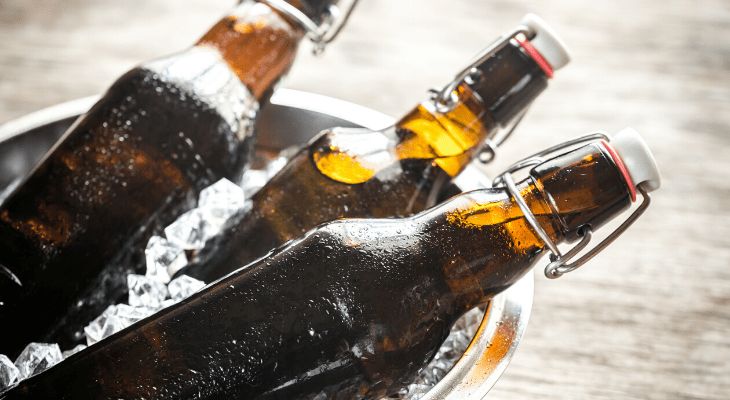
What Are the Different Kinds of Ice Beer?
There are a lot of different kinds of ice beers. All brewed by almost the same characteristic method, freeze distillation. But, some have turned out better than others, to put it mildly.
Here is my top 5 list over the best ice beers.
#1 Hite Extra Cold
Hite Brewery Company LTD
With 87 years of beer brewing know-how since 1933, this is Korea’s first freeze distilled beer. This beer, however, does not have a much higher alcohol content than average beers with only 4.3% ABV, and certainly not compared to other ice beers.
This ice beer is very light and clear in the color, and very clean in the taste. This doesn’t come with a lot of flavor, but it is definitely a try worthy. All in all, this is actually a good ice beer, after all.
#2 Bud Ice
Anheuser-Busch InBev
Though beer critics have called Bud Ice lacking in personality, along with other ice beers, this ice-brewed sibling of Bud Light has shipped an increasing amount of barrels each year since 2014.
It’s comparatively low in calories for a non-light beer, with 123 per 12-ounce bottle, compared to the company’s Natural Ice which has 130 per 12-ounce.
#3 Natural Ice
Anheuser-Busch InBev
And now to the Natural Ice Beer as I describe in the section above. This is an ice-brewed lager made with both malted barley and corn. Natural Ice is a spinoff from Anheuser-Busch’s Natural Light, also known as Natty.
Slightly higher in alcohol content than the company’s Bud Ice, it is considered by reviewers to be bland but clean in flavor.
#4 Icehouse
Molson Coors Brewing Company
This is another ice beer from Molson Coors Brewing Company. In Texas, an icehouse is an old-style neighborhood tavern, at least partially open to the outside.
However, the Icehouse lager has nothing to do with Texas. Its name indicates that it’s an ice beer. Some would even say it was the first one produced in America, introduced in 1993.
#5 Milwaukee’s Best Ice
Molson Coors Brewing Company
Milwaukee’s Best Ice is one of several ice-style lagers that rank among America’s favorite beer brands.
This ice beer is made by the freeze distillation. In the case of Milwaukee’s Best Ice, it has increased the alcohol content by more than a full percentage point to 5.9% ABV compared to Milwaukee’s Best Premium.
So, ice beers might not be loved by most beer enthusiasts like me, though it is still a pretty good selling beer along America. My advice for you is to try out an Eisbock instead of an ice beer. I’m sorry to say, but then you’ll have a better experience.

Read this post to learn even more about beer: What Is A Saison Beer?




